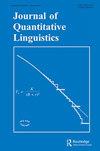A Zipfian Approach to Words in Contexts: The Cases of Modern English and Chinese
IF 1.7
2区 文学
0 LANGUAGE & LINGUISTICS
引用次数: 0
Abstract
ABSTRACT The system-level complexity of language has been thoroughly investigated in terms of Zipf’s law, whose quantitative features have proved to reflect text/language typology. This study extends the scope of Zipf’s law from the macroscopic scale of language to specific words in contexts, with the aim of examining its potential as an indicator of word typology. The focus is confined to the high-frequency words in English and Chinese as found in the FLOB and LCMC corpora. It has been found that the log–log rank-frequency distributions of contextual words of the words in question generally abide by the linear function y = ax+b. Moreover, it has been shown that an adjusted version of parameter a can help to distinguish the words in question’s classes. The contextual information as reflected by this Zipf-based index might be more important to the emergence of word classes of Chinese, which has no real inflection as a word-class indicator. From a Zipfian approach, the findings have preliminarily approved Saussure’s systems thinking regarding linguistic signs. Meanwhile, they may also contribute to such fields as usage-based linguistics.Zipfian语境中的词语研究——以现代英汉为例
摘要从齐普夫定律的角度对语言的系统级复杂性进行了深入的研究,其数量特征已被证明反映了文本/语言类型学。本研究将齐普夫定律的范围从语言的宏观尺度扩展到语境中的特定单词,目的是考察其作为单词类型学指标的潜力。焦点仅限于FLOB和LCMC语料库中的英语和汉语高频词。研究发现,所讨论单词的上下文单词的对数-对数秩频率分布通常遵循线性函数y=ax+b。此外,研究表明,参数a的调整版本可以帮助区分问题类别中的单词。这种基于齐普夫指数的语境信息可能对汉语词类的出现更为重要,汉语词类没有真正的屈折作为词类指标。从齐普法的角度来看,这些发现初步认可了索绪尔关于语言符号的系统思维。同时,它们也可能对基于使用的语言学等领域做出贡献。
本文章由计算机程序翻译,如有差异,请以英文原文为准。
求助全文
约1分钟内获得全文
求助全文
来源期刊

Journal of Quantitative Linguistics
Multiple-
CiteScore
2.90
自引率
7.10%
发文量
7
期刊介绍:
The Journal of Quantitative Linguistics is an international forum for the publication and discussion of research on the quantitative characteristics of language and text in an exact mathematical form. This approach, which is of growing interest, opens up important and exciting theoretical perspectives, as well as solutions for a wide range of practical problems such as machine learning or statistical parsing, by introducing into linguistics the methods and models of advanced scientific disciplines such as the natural sciences, economics, and psychology.
 求助内容:
求助内容: 应助结果提醒方式:
应助结果提醒方式:


